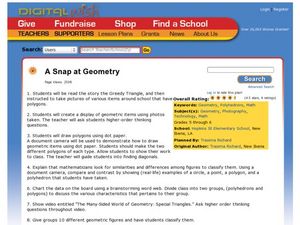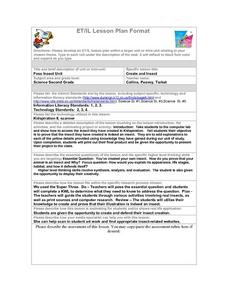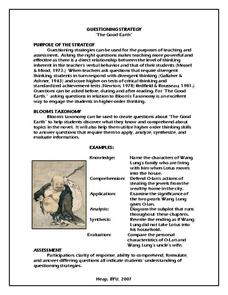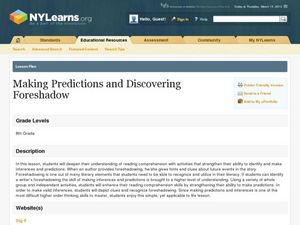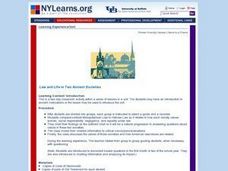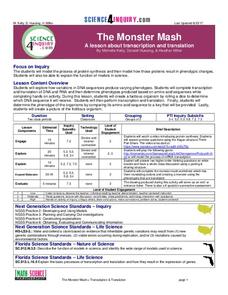Curated OER
Harriet The Spy
Fourth graders investigate the style of diary writing as its own genre of literature. They read Harriet The Spy in order to have a text for this literature study. Students use the skill of prediction to preview the story, and then...
Curated OER
Outside - Inside Drawings
Students use observational drawing to study the unfamiliar They use oil pastels to mix/blend colors. They be introduced to using drawing as a tool for documenting what we can learn from close observation.
Curated OER
Polynomials and Factoring
Learners classify, add, subtract, and factor polynomials. In this polynomials instructional activity, students classify polynomials by creating their own system. During a discussion, the class decides on a common system. They add and...
Curated OER
World Marriage Day
In this World Marriage Day worksheet, students read or listen to a passage, then match phrases, fill in the blanks, choose the correct word, unscramble words and sentences, put sentences in order, write discussion questions and conduct a...
Curated OER
A Snap at Geometry
Students study geometric images and polyhedrons. In this geometry lesson plan, students complete several activities to learn about geometric shapes and classify polyhedrons from polygons. Students watch a video, complete a web-directed...
Curated OER
Insect Unit
Second graders use technology to investigate the concept of an insect. They use Kidspiration in order to create an insect. Then research is conducted to match the picture with the correct insect. Then students write a report about the...
Curated OER
Olympic Awareness
Students, using the Internet, research the Olympic Games in Torino, Italy. They keep a journal of highlights and think about what they have learned about the sport of their choice.
Curated OER
Goods and Services Scavenger Hunt
First graders conduct research into the concepts of goods and services. The information is used in order to create a definition for each concept. Then the information is organized using the scavenger hunt format. Further extension to the...
Novelinks
The Good Earth: Questioning Strategy
Readers use Bloom's Taxonomy to create multi-level questions about Pearl Buck's The Good Earth.
Curated OER
Foreshadowing and Making Predictions
"What happens next?" Using real-life scenarios, movies, images, and other prompts, pupils practice making predictions based on inferences from clues. A SMART board activity takes them from making predictions to writing a prediction...
Curated OER
CAN WE SWITCH GENDERS OF STORY CHARACTERS?
Analyze characters and stories to identify stereotyping. Learners will examine the concept of character gender to evaluate bias in classroom story books. They are asked to read a story or play and change the gender of the character to...
Curated OER
Silas Marner by George Eliot
Mary Anne Evans, better known by her pen name George Eliot, wrote Silas Marner in 1861. While you're compiling materials for your Victorian unit, consider printing off these essay questions to help readers really explore the text. Some...
Intel
Energy Innovations
Collaborative groups examine the importance of energy resources on quality of life by researching different energy sources and alternative energy sources through data analysis. They make a comparison of different countries and cultures,...
Curated OER
Problematic Situation: Romeo and Juliet
Is it ok to be mad at someone who comes to your party uninvited? What about someone who interrupts you? For this prereading strategy, your class members must decide whether or not they'd get angry in the 10 situations provided. Then,...
Novelinks
Nightjohn: Bloom's Taxonomy Questions
After completing Nightjohn, Gary Paulsen's young adult novel about slavery set shortly before the Civil War, readers respond to a series of questions crafted to reflect Bloom's taxonomy.
Curated OER
Law and Life in Two Ancient Societies
Students work in groups and compare/contrast Mesopotamian Law to Hebrew Law. They chart their findings on a chart to show a natural progression to answering questions about values in these two societies.
Intel
Help Wanted! Physicist
Groups discover physics as they take an assigned scenario, perform research about different aspects of the subject matter, and present their findings to the class. From the presentations, learners must develop and support a point of view...
Intel
Designer Genes: One Size Fits All?
In this STEM group of 10 activities, lesson two focuses on the question, "Just because we can, should we?" when considering genetically engineered food. Classes hear a scenario and, as young scientists and geneticists, must determine if...
Intel
Biomes in Action
A STEM project-based learning lesson, number four in a series of 10, focuses on human impacts to biomes around the world. Groups work together as environmentalists to research a specific biome, investigating human impacts on it. From...
Curated OER
Modular Packaging
Students. in groups of two or three, design a box that contain a product. They must utilize design skills, spatial relationships, measurement skills and problem solving in order to design the most economically advantageous packaging.
Science 4 Inquiry
The Monster Mash
Young scientists create monsters by applying their knowledge of transcription and translation. They randomly find the DNA, assign it a codon, and build monsters piece by piece.
Curated OER
What Size Is It?
The concept of size is taught in this comparitive meaning of words lesson. Learners discuss the comparative qualities of words such as small, smaller, smallest. They demonstrate their understanding by drawing a picture.
Curated OER
Choose Your Own Adventure: School Nutritional Policy
Mature audiences are required for this lesson on implementing health-related policies. First, they openly explore the CDC obesity page while taking notes about what they discover. Then they view a PowerPoint about the success of public...
Curated OER
Out of the Dust: Questioning Strategies
Bloom's Taxonomy is a great way to address the many levels of comprehension. With explanations and examples of each level, you can create questions that focus on knowledge, comprehension, application, analysis, synthesis, and evaluation.






